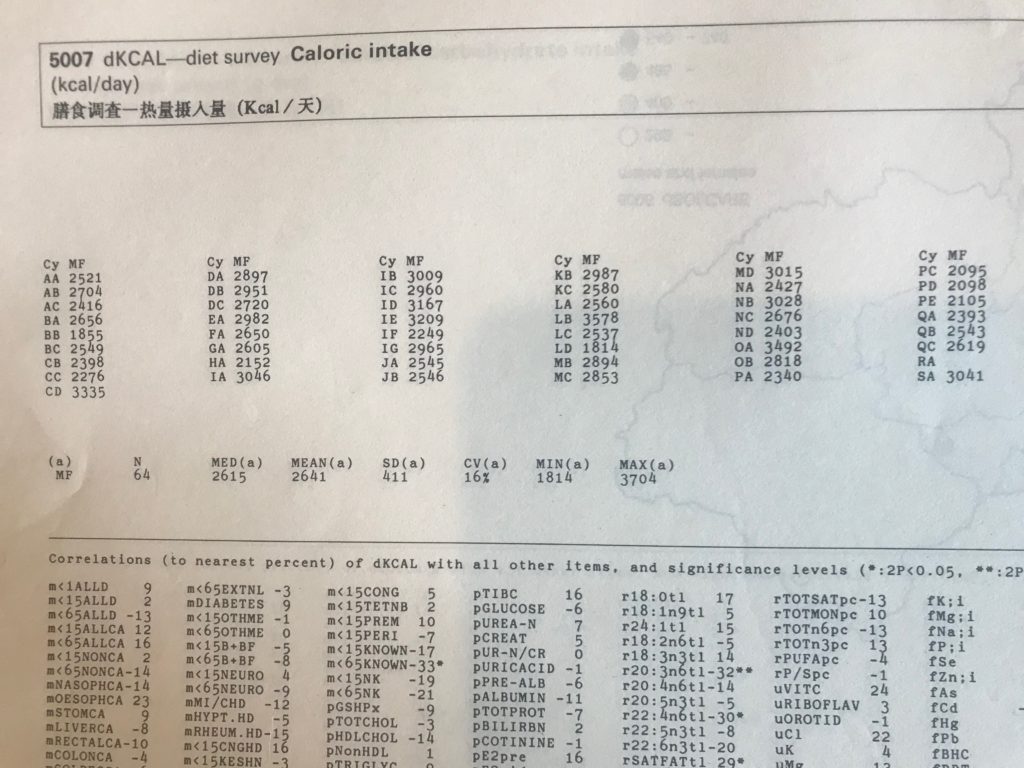In The ROS Theory Of Obesity I stated without providing evidence that Chinese people in the 1980s were lean while eating a high starch diet. In the comments thread, it was suggested that perhaps the Chinese were thin due to lack of available calories. There simply wasn’t enough food to go around.
When I wrote The ROS Theory of Obesity I was thinking of the “China Health Study”, the original 900 page data summary manuscript published in 1990 by Oxford and Cornell University Press entitled “Diet, Life-style and Mortality in China”. It can only be found in University libraries and rare bookstores. One of the authors, T Colin Campbell later published a pseudo-scientific paperback called “The China Study”, but that’s not what I’m talking about. “Diet, Life-style and Mortality in China” has been sitting on my coffee table for the last 16 years. I originally blogged about what it suggests about the health effects of wheat consumption way back in 2005, before anyone had heard the term “gluten free”.
It is a compelling study on the effects of diet on various health outcomes. What makes it so compelling is that at the time of the survey, 1983, eating patterns in China were still very localized. There are rice consuming areas, sweet potato consuming areas, wheat consuming areas, seafood consuming areas, dairying areas and more. Very little imported food, such as vegetable oil or or sugar, were being consumed. Food consumption was closely monitored – including weighing portions of food before cooking and leftover portions that were not eaten – and an array of measurements were taken including height and weight, the fatty acid content of red blood cell membranes, hormone levels, etc. All of this is compared to a national survey of mortality that was conducted from 1973-75.

I can’t say for sure how many calories the Chinese were eating in the years leading up to 1983, but since most of the food consumed was produced locally and since no famines have been reported since 1961, I have to assume that the amount of food consumed in 1983 was fairly typical. Since the Chinese of 1983 were considerably smaller than modern Americans, I decided to compare calories consumed per lb of human being. The difference is stunning. I am pulling the American data for weight and caloric consumption from here and here. I am using adult males as the reference because that’s how it was reported in the China study.
| Chinese Male Office Worker (1983) | Avg American Male 2016 | |
| Weight in pounds | 121 | 199 |
| Caloric Consumption | 2641 | 2566 |
| Calories Consumed Per Pound | 21.8 | 12.9 |
The American estimate is taken from NHANES data, which uses a 24 hour food recall questionnaire to assess dietary consumption. This method is notorious for underestimating caloric intake because people tend to underestimate portion sizes or forget items. What did you eat for breakfast yesterday? What was the portion size? It’s not easy to get right but it’s the only survey we have (that I know of) that actually tries to estimate average caloric intake.
With that caveat aside, the difference in calories consumed per pound of body weight between the average Chinese male and the average American male is stunning. Is the difference because the Chinese men were out working in the fields all day? No. In the China study, the reported caloric consumption was broken into people of five different activity levels. The 2641 were the average calories consumed by men in the first activity level, “very light (e.g., office work, radio and watch assembly and repair)”.
So just how thin were they? The average BMI of males in China in 1983 was 20.4. That is very thin indeed. And the vast majority of Chinese DO eat a very high starch diet. Keep reading and you’ll see.
The assumption that Chinese people eating a high starch diet remained lean because caloric consumption is low seems to be simply a fallacy.

Hi,
In the last part of ROS Theory of Obesity, when explaining the Chinese diet, you said ” White rice has very little fat to contribute so your fat stores will be very saturated. ”
From that I understand that our fat stores can be either saturated or unsaturated. So, my question is, how can I know which kind of fat store I’ll get from the carbs I’m eating? How can I plan my diet including carbs but in a way that the fat is not being stored as unsaturated?
Thanks! This is an awesome work!
Hey Eduardo!
So, when your body makes fat from carbs, it can ONLY make saturated fat. Once the fat is made, an enzyme, SCD1, can convert that fat to monounsaturated fat. But humans CANNOT make PUFA, so if you don’t eat them you won’t have them. So fats from carbs are going to be stored as a mixture of saturated and MUFA. The ratio seems to be determined simply by the amount of SCD1. More on that to come.
Brad